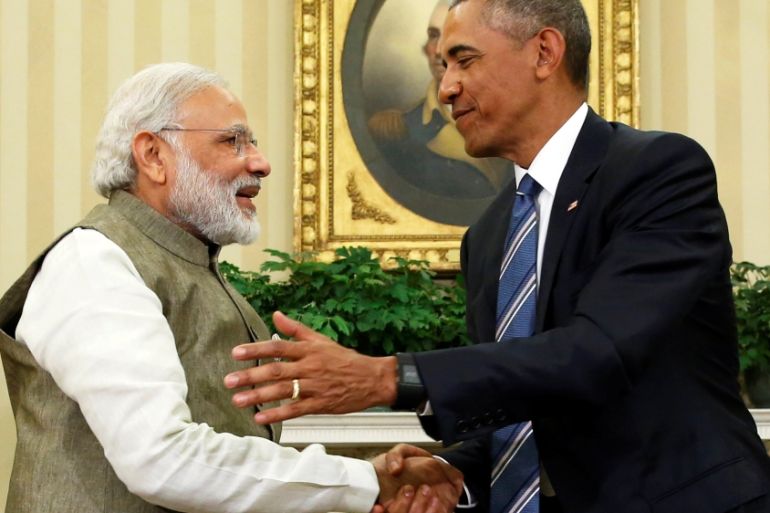India-US ties: Marching to a new tune
This turnaround in the ties is in stark contrast to the Cold War-era when the two sides did not see eye-to-eye.

In his recent address to a Joint Session of the United States Congress, Indian Prime Minister Narendra Modi remarked that “there is a new symphony in play”.
He couldn’t have described it any better. Indeed, his recently-concluded visit to the US marks the beginning of a new era in the ties between the world’s largest democracy and one of its oldest.
This could well be the final bilateral summit between the two sides before US President Barack Obama demits office early next year. Incidentally, Obama became the first US president to visit India twice during his presidency.
A new beginning
This turnaround in the ties between India and the US is in stark contrast to the Cold War-era, when the two sides did not see eye-to-eye.
It is also a sea-change from the downslide in the ties towards the end of the previous United Progressive Alliance (UPA) government’s tenure in New Delhi, which was marked by acrimony over the strip-search of an Indian diplomat in the US.
Since 2014, Prime Minister Modi leads a government which has a commanding majority in the Lok Sabha (the lower house of the Indian Parliament).
That majority is not bogged down by the demands of coalition partners when it comes to making hard decisions on the foreign policy front, as had happened during the tenure of the former Prime Minister Manmohan Singh.
The US has now recognised India as a “major defence partner”, which will facilitate “technology sharing with India to a level commensurate with that of its closest allies and partners”.
OPINION: What of India and China relations?
This will be crucial for the success of the Modi’s “Make in India” initiative, which aims to curb the high unemployment rate.
In addition, preparatory work has already started in India for the construction of six nuclear reactors to be built by US-based Westinghouse, marking the long-delayed commercialisation of the India-US civilian nuclear deal.
Why now?
This new-found bonhomie between India and the US has irked Pakistan, which has been a “major non-NATO ally” of the US, and has also ruffled quite a few feathers in Beijing. Pakistan has been unhappy over US’ backing of India’s bid for membership of the Nuclear Suppliers Group, among others.
While the personal chemistry between Modi and Obama has been there for all to see, at the same time, there are a host of factors that are driving the two countries closer.
For one, the upswing in Indo-US ties owes a big deal to the shared aims of the two countries in the Asia-Pacific realm, which includes concerns about China’s aggressive moves in the region.
It would still be presumptuous to infer that India and the US are on the same page on each and every issue.
Beijing has been displaying an increasingly assertive stance recently, especially in the South China Sea. The US has been sending not-so-subtle warnings to Beijing with repeated “freedom of navigation” operations in the region.
At the same time, the US “rebalance” or “pivot” to the Asia-Pacific gels well with India’s “Act-East Policy” through which New Delhi aims at reinvigorating its ties with countries in Southeast Asia and East Asia.
India is emerging as a major player in its neighbourhood and, along with the US, is one of the biggest international donors in Afghanistan. Prior to his US trip, Modi had inaugurated the Afghan-India Friendship Dam in Afghanistan, built with Indian assistance.
Also, India now buys a range of defence hardware from the US and has purchased weapons worth about $10bn between 2005 and 2015.
New Delhi was the world’s biggest importer of weapons between 2011 and 2015, and this has been under the radar of the US defence manufacturers. In the past, India used to rely heavily on Russian-made defence hardware, but this is not the case now.
International presence
Moreover, India requires the US to do some heavy lifting on its behalf in international forums. New Delhi has been pitching for permanent membership of the United Nations Security Council, and the US has backed this bid.
Besides, if India is to get into forums like the Nuclear Suppliers Group, the Wassenaar Arrangement and the Australia Group, Washington’s influence and leverage in these groups could be crucial. India’s entry into the Missile Technology Control Regime is almost certain with help from the US.
![Modi gestures after addressing a joint session of Congress in the US Capitol in Washington, DC [Reuters]](/wp-content/uploads/2016/06/e532e39305494d4da02750c8b58f78f5_18.jpeg)
During his two terms in office, Obama has recast US foreign policy in ways that no other president in recent memory has. Whether it be his outreach to Iran, Cuba, Vietnam among others, he has presided over a period when the US has completely stopped seeing India and Pakistan through the same prism.
And during the same period, Pakistan’s importance has dropped on the US foreign policy radar. The recent killing of the Afghan Taliban chief and the killing of Osama bin Laden in Abbottabad both inside Pakistan has also forced Obama’s hand when it comes to US’ ties with Pakistan.
In addition, Pakistan’s growing ties with its “all-weather ally”, China, has also been factored in by policy-makers in Washington. Beijing’s decision to invest $46bn in the China-Pakistan Economic Corridor which will connect Kashgar in Western China to Gwadar in Pakistan on the Arabian Sea front is a sign of the growing cosiness between Islamabad and Beijing.
The future look-out
It would still be presumptuous to infer that India and the US are on the same page on each and every issue. There is still dissonance between the two on issues like Syria, some specific trade affairs and intellectual property rights. Besides, New Delhi has always had a policy of “strategic autonomy”, and is in no hurry to give up on the same.
OPINION: Obama’s pivot east fuels an Asian Cold War
However, earlier, in April this year, India had agreed “in principle” to sign the Logistics Exchange Memorandum of Agreement, making it clear that New Delhi has no qualms about sharing military facilities with the US – on a reciprocal basis).

This is a major leap forward for Indian foreign policy as never before in its independent history, New Delhi had opened its bases to foreign troops.
Though this agreement does not allow for the stationing of US troops on Indian soil, Washington now sees India as a trustworthy partner. It is this trust and shared interests which, as in Modi’s own words, have made India-US ties “overcome the hesitations of history”.
Rupakjyoti Borah is currently a research fellow with the Tokyo-based Japan Forum for Strategic Studies.
The views expressed in this article are the author’s own and do not necessarily reflect Al Jazeera’s editorial policy.
